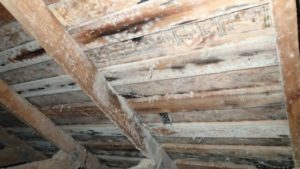White Mold Under House/Building & Crawl Space
Commonly, you should look for white mold under your house or commercial property and white mold in your crawl space. They are quite common due to the moisture and humidity in those areas. Here is additional information about mold and what to do if you suspect that you have mold in any part of your property.
What White Mold Looks Like
White mold obviously is white in color, but also often looks fuzzy, cotton like, and/or fluffy in texture. If you see anything like this growing in your property, especially in a relatively large area, it would be a good idea to speak with a local mold remediation company by dialing the number on our website.
How Mold Spreads
Mold typically spreads by releasing spores into the air. These spores can turn into new mold colonies if they find the proper conditions (moisture and a food source). One of the issues with white mold under a house or building is that moisture rises. So some of the moisture in the crawl space/under the house could make it’s way through the HVAC system and into the rest of your property.
How Fast Does Mold Grow
This will vary a lot based off of the conditions and the spores present in the environment, but mold can begin growing within 24-48 hours of a water damage incident.
White Mold vs Black Mold
The difference between white mold and black mold is that white mold is sometimes called mildew and is considered to be a little bit less harmful to your health than black mold is. The most common species of black mold is Stachybotrys Chartarum and it is highly toxic because it releases a fairly large amount of mycotoxins into the environment. White mold, on the other hand, does not release quite as many of these substances, but it can still cause some health issues.
Is White Mold Dangerous/Toxic to Humans and Other Organisms?
As we mentioned in the section above, white mold tends to be slightly less hazardous to peoples’ health than black mold, but it can still cause negative health effects. That being said, here are some of the health effects that are often related to mold:
- Headaches
- Itchy eyes
- Sinus problems
- Watery eyes
- Fatigue
- Focus problems
If you are experiencing any of these symptoms, especially if they started happening after your home retained water damage, you should visit a doctor regarding your health and call a professional mold contractor as soon as possible to help you remediate the problem. The longer you stay in this environment, the more damage it could be causing you. If you would like to learn more about the health effects caused by mold you can check out this EPA article.
Why Mold Growth in Crawl Spaces or Under Houses and Commercial Buildings Is Common

Mold typically needs moisture and a food source like wood in order to grow properly. Due to the high moisture and humidity levels that are often found in crawl spaces and under buildings, mold is commonly found growing there. In fact, the humidity is so high in a crawl space that mold growth actually requires less water than it might need in a less humid part of your property.
Where Else Is White Mold Often Found?
White mold is found in many place, both indoors and outdoors. If you have white mold in your crawl space you may also notice it growing on or in a few of the following places:
- Furniture
- Clothing
- Carpet
- Basements
- Attics
How to Get Rid of White Mold Under a House or Other Building/What Causes White Mold
Because moisture is an important factor for mold growth, it is important that you get rid of it as soon as possible. If you are looking for how to get rid of white mold under a house or other building, we suggest that you run a moisture test to see where the moisture is coming from, allowing you to mitigate it quickly.
You can call the number on our website to be connected with a restoration contractor who will gladly help you out, or can attempt to do it yourself by using a moisture meter like the one found at this url. After you detect the moisture source, you will need to shut it off and dry the affected areas in order to stop mold growth. As a final step, it is a good idea to remove and replace any materials that may have been affected by the mold, as well as to use a mold cleaning agent like Mold Armor.
Important: Do not use bleach to clean the mold as it will not properly kill it, and will often times put the mold into panic mode instead, causing it to release spores.
How to Prevent Mold from Coming Back
Mold will try to grow back if there is still moisture and a food sources present for it to do so. Your goal in the prevention of mold growth should mainly be to eliminate these sources. There are some precautions you can take to reduce the moisture in your crawl space and, as a result, lower your chances of getting mold. Here are a few of them:
- Make sure that there are no cracks in your foundation walls
- Get your crawl space encapsulated/waterproofed
- Confirm that the current insulation is in good shape. If it looks like it is gone or dropping, it could be a sign of water damage.
- Make sure that there are no leaks around your air ducts or plumbing parts
Why Hire a Mold Removal Expert?
As we mentioned above, it is possible that the mold will come back if you do not remediate it properly. In addition, professionals have much more powerful equipment and are trained to take the exact steps required to make and keep your property mold free.
If you have white mold in your home or commercial structure or if you are experiencing symptoms of mold exposure, a professional mold removal expert can help properly diagnose and fix the issue. Call the number on our website for a free, no obligation quote from an expert in your area!
